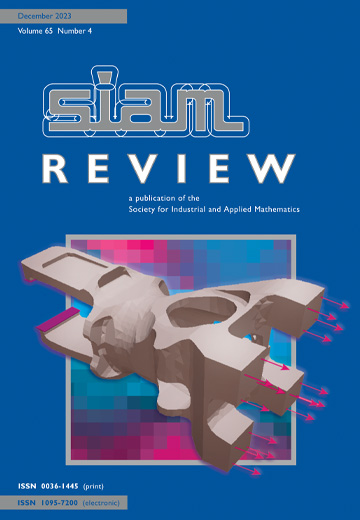SIGEST
IF 6.1
1区 数学
Q1 MATHEMATICS, APPLIED
引用次数: 0
Abstract
SIAM Review, Volume 66, Issue 4, Page 719-719, November 2024.The SIGEST article in this issue, “A Bridge between Invariant Theory and Maximum Likelihood Estimation,” by Carlos Améndola, Kathlén Kohn, Philipp Reichenbach, and Anna Seigal, uncovers the deep connections between geometric invariant theory and statistical methods, specifically maximum likelihood estimation (MLE) by connecting it to norm minimization over group orbits. The authors develop a dictionary relating stability notions in geometric invariant theory to the existence and uniqueness of MLEs, which applies to both Gaussian and log-linear models. In comparison to the original 2021 version of the paper that appeared in the SIAM Journal on Applied Algebra and Geometry, for the SIGEST version, the authors added new content on log-linear models, simplified technical proofs, removed detailed appendices, and incorporated new examples and figures for accessibility. In particular, the focus was primarily on Gaussian models, whereas this updated SIGEST version expands the coverage by incorporating results from the authors' companion paper on log-linear models. Furthermore, a new figure (Fig. 1) visually illustrates the two core concepts of invariant theory and MLE. Significant changes include the removal of technical details and appendices to streamline the content and make it more accessible to a broader audience. The introduction of examples, particularly for the Kempf--Ness Theorem, further aids understanding. This paper makes several key contributions of broad mathematical interest. MLE is a key statistical technique that is widely used. Having a new handle on its well-posedness analysis deepens the understanding of the mechanisms behind this technique as well as potentially paves the way to extending existing theory for MLE models. Also, on the computational side, algorithms from the optimization over orbits can be used for MLE, and vice versa, which could possibly lead to new and more efficient algorithms in both fields. Overall, the work beautifully highlights how techniques from one field can be applied to the other, with applications to generalization bounds, group actions, and optimization landscapes. In the last section of their SIGEST paper the authors discuss possible future research directions that capitalize on the dictionary they have uncovered.
SIGEST
SIAM 评论》,第 66 卷第 4 期,第 719-719 页,2024 年 11 月。 本期的 SIGEST 文章《不变量理论与最大似然估计之间的桥梁》由 Carlos Améndola、Kathlén Kohn、Philipp Reichenbach 和 Anna Seigal 撰写,通过将几何不变量理论与群轨道上的规范最小化联系起来,揭示了几何不变量理论与统计方法,特别是最大似然估计 (MLE) 之间的深层联系。作者编写了一本词典,将几何不变理论中的稳定性概念与最大似然估计的存在性和唯一性联系起来,适用于高斯模型和对数线性模型。与最初发表在《SIAM 应用代数与几何杂志》上的 2021 年版论文相比,作者在 SIGEST 版本中增加了关于对数线性模型的新内容,简化了技术证明,删除了详细的附录,并加入了新的示例和图表,以方便读者阅读。特别是,该书的重点主要放在高斯模型上,而 SIGEST 更新版则通过纳入作者关于对数线性模型的配套论文中的结果,扩大了覆盖范围。此外,新图(图 1)直观地说明了不变理论和 MLE 这两个核心概念。重大改动包括删除了技术细节和附录,以精简内容,让更多读者更容易理解。例子的引入,尤其是 Kempf-Ness 定理的例子,进一步加深了读者的理解。本文做出了几项具有广泛数学意义的重要贡献。MLE 是一种广泛应用的关键统计技术。对它的问题分析有了新的把握,可以加深对这一技术背后机制的理解,并有可能为扩展 MLE 模型的现有理论铺平道路。此外,在计算方面,轨道优化的算法也可用于 MLE,反之亦然,这有可能为这两个领域带来更高效的新算法。总之,这项研究成果很好地强调了一个领域的技术如何应用于另一个领域,并应用于广义边界、群作用和优化景观。在 SIGEST 论文的最后一部分,作者讨论了利用他们所发现的字典可能的未来研究方向。
本文章由计算机程序翻译,如有差异,请以英文原文为准。
求助全文
约1分钟内获得全文
求助全文
来源期刊

SIAM Review
数学-应用数学
CiteScore
16.90
自引率
0.00%
发文量
50
期刊介绍:
Survey and Review feature papers that provide an integrative and current viewpoint on important topics in applied or computational mathematics and scientific computing. These papers aim to offer a comprehensive perspective on the subject matter.
Research Spotlights publish concise research papers in applied and computational mathematics that are of interest to a wide range of readers in SIAM Review. The papers in this section present innovative ideas that are clearly explained and motivated. They stand out from regular publications in specific SIAM journals due to their accessibility and potential for widespread and long-lasting influence.
 求助内容:
求助内容: 应助结果提醒方式:
应助结果提醒方式:


